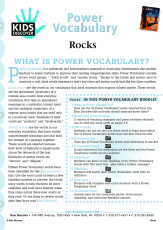If you look at pictures of Earth from space, you can see what a rocky planet we live on. The continents are vast shields of stone, with mountains covering one-fifth of the land area. The oceans are dotted with islands—and the dark seas conceal rocky bottoms.
There are only four terrestrial (rocky) planets in our solar system: Mercury, Venus, Earth, and Mars. (The other four—Jupiter, Saturn, Uranus, and Neptune—are not solid, but made mostly of gas.) On Earth, the surface is often covered with signs of life—forests, grasslands, oceans, and lakes—but on the other terrestrial planets and the Moon, the rocky terrain is visible everywhere.

Earth is an astonishing 4.6 billion years old. But it hasn’t always looked the way it does now. Most people think of the rocky part of Earth as solid and unchangeable. But rocks and landforms can melt and even vaporize. Meanwhile, new rocks are continually being formed. In fact, the youngest rocks on Earth are being formed right this moment as lava bursts and oozes out of cracks in our planet’s surface.


To understand how rocks form and the Earth’s geology, you need to know that our planet’s surface is broken up into sections called “plates.” All the plates fit together like pieces of a jigsaw puzzle, and they are moving—although very slowly. Some push into each other and others pull apart. The plates are able to move because the layer of Earth below them is partially melted. The plates “float” on this soft, liquidy layer.
The slow movement of the plates is driven by heat energy rising up from deep within Earth. Over millions of years, heat energy has driven the continents into different positions and built mountain ranges. Ever wonder why South America and Africa look like they could fit together like puzzle pieces? It’s because they were squashed together—and only began splitting apart about 150 million years ago.
The process of mountain building also takes millions of years. The Himalayan mountains are the highest in the world, and they are still growing—about one centimeter every year—as two of Earth’s plates are squeezed together, forcing the land upwards.


Rocks come in an amazing variety of colors and forms. But there are only three basic types: igneous, sedimentary, and metamorphic.
Igneous rocks are forged in fire. Heat energy deep inside Earth sometimes causes rocks underground to melt. This hot, liquefied rock is called magma. In places where the Earth’s plates are moving apart, magma can break through to the surface. When that happens at a hotspot like a volcano, it’s called lava. As magma and lava cool down and harden, they form igneous rocks. Two examples of igneous rocks are obsidian and granite. They don’t look much alike. Obsidian forms when lava cools quickly—and it looks like smooth black glass. Granite forms when magma underground cools very slowly, sometimes over millions of years. The super-slow cooling allows visible crystals to form in the granite—and it looks course and grainy.



While mountains are being built up and new rocks are being formed, others are being eroded away. Water and wind break down rocks into pebbles and finally into tiny bits that form layers of mud or sand that are deposited in riverbeds and off coastlines. Over long periods of time, these layers of sediment get buried under new layers, and the weight of these new layers becomes heavier, building up pressure until the sediment begins to compress and cement together. Eventually, it turns into sedimentary rock.



Metamorphic rocks are made from existing rocks that have been dramatically changed by high heat and pressure. One way they form is when two of Earth’s plates collide and the rocky edges of the plates are folded, crushed and sometimes pushed deep underground. Temperatures as low as 400 degrees Fahrenheit can cause the rock to change its chemical and physical form. The high pressure can make the different minerals in the rocks realign into sheets, sort of like the pages of a book.
One common type of metamorphic rock is slate. Slate starts its life as a sedimentary rock, made of fine grains of clay. When it’s subjected to heat and pressure, the clay minerals change into mica minerals that form sheets.



Minerals are the building blocks of rock. Some rocks are made of a single type of mineral. But most are made of a few types joined together. Altogether there are about 4,000 types of minerals. Every mineral has its own chemical composition and properties, such as what temperature it melts at, how hard it is, what color it is, and how lustrous (shiny) it is.
Quartz is a very common mineral found in granite, sandstone, and lots of other rocks. It’s made of just two elements, silicon and oxygen—and it has a very high melting temperature: about 3,000 degrees Fahrenheit. Pure quartz is clear. But minor chemical changes can turn quartz different colors. Large crystals of purple quartz are called amethyst. Pink quartz is called rose quartz. Yellow quartz is called citrine. Compared to many other minerals, quartz is quite hard—even harder than steel.


The hardest minerals in the world—diamonds—are made from one of the most common element: pure carbon. But here’s the strange thing. Graphite—one of the softest minerals in the world—is also made of pure carbon. What makes diamonds and graphite different is the way the carbon atoms are arranged. The carbon in graphite is arranged in micro-thin sheets, making the dark gray graphite so soft that it leaves a mark when dragged across a surface. (That’s why graphite is used to make pencil lead). Diamonds, however, are formed under intense pressure hundreds of miles below Earth’s surface. The powerful bonds forged by their carbon atoms have a cubic crystal structure. That structure keeps diamonds stable and solid while hot magma is being formed into igneous rock around them.




